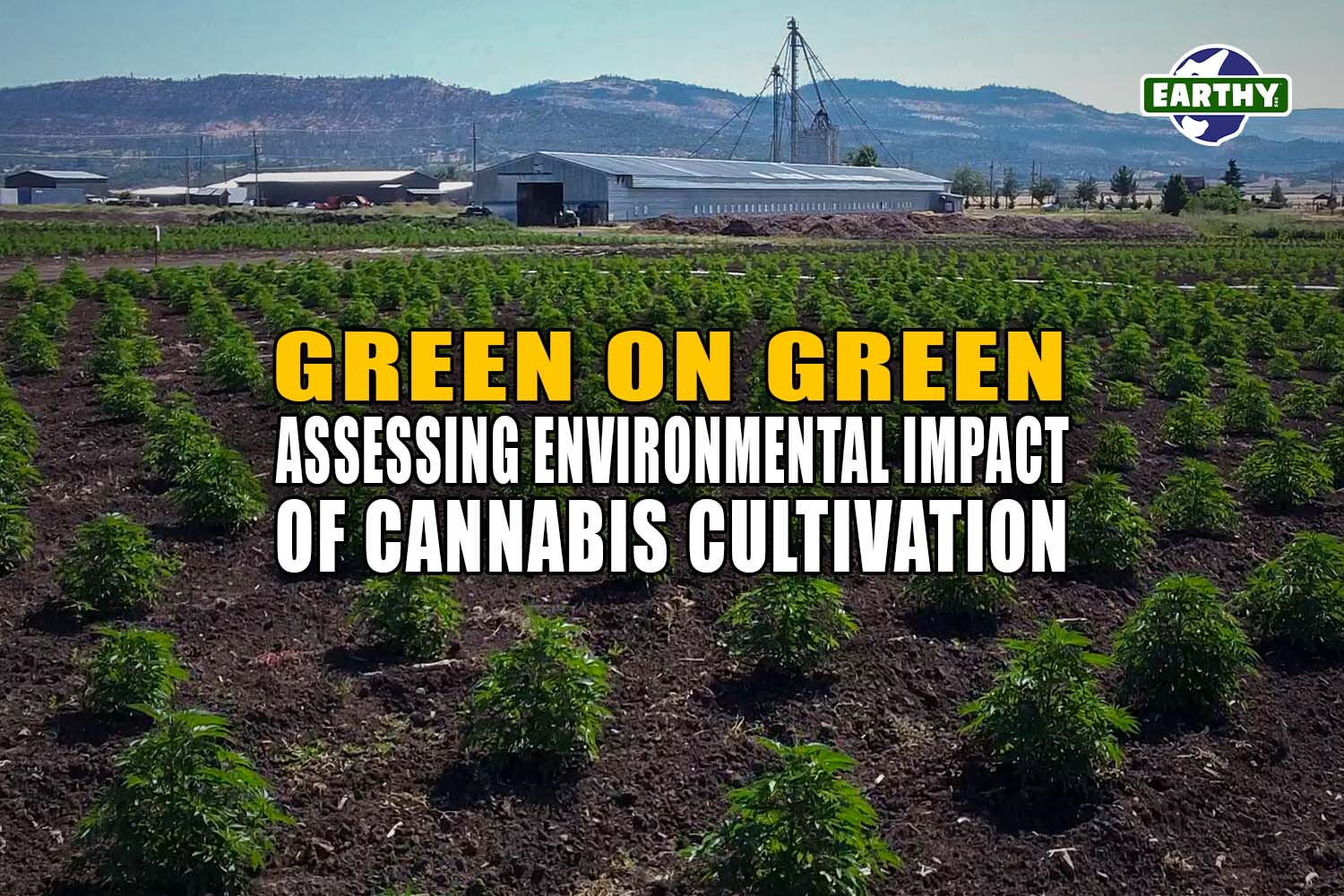As the cannabis industry experiences unprecedented growth, the environmental impact of cannabis cultivation has come under increasing scrutiny. Indeed, with legalization expanding across various regions, the number of cannabis cultivation sites has surged. As a result, a growing number of environmentalists raise concerns about the sustainability of these practices [1]. This article explores the environmental consequences of growing cannabis, focusing on the different cultivation methods, resource usage, and the potential for sustainable practices.
How to grow marijuana or hemp while considering the environmental impact
Cannabis cultivation has three main methods: outdoor cultivation, indoor cultivation, and greenhouse cultivation. Respectively, each method has distinct environmental implications, depending on the resources used and the scale of the growing operations.
- Outdoor cultivation relies heavily on natural resources such as sunlight, soil, and water. As such, it involves growing cannabis in open fields, where plants experience the full spectrum of environmental conditions. For instance, the plants face fluctuating temperatures, varying humidity levels, and natural rainfall. While outdoor growing generally has low costs and utilizes fewer artificial inputs, it can lead to habitat disruption and water resource depletion [2].
- Indoor cultivation, on the other hand, offers total control over the growing environment. Thus, this method allows cannabis cultivators to fine-tune factors like light cycles, temperature, and humidity control. Additionally, indoor growers often use high-pressure sodium, metal halide, or ceramic metal halide grow lights to provide the necessary light spectrum for cannabis growth. However, this method consumes significant energy, contributing to a larger carbon footprint [2].
- Greenhouse cultivation strikes a balance between the two. For example, it employs natural sunlight while offering some level of environmental control. Moreover, greenhouses can extend the growing season and optimize resource usage. Even so, they require energy for heating, cooling, and ventilation systems [2].
Eco-friendly Cannabis: Sustainable Practices in Cultivation and Consumption
Water usage in cannabis cultivation
Water is a critical resource for cannabis plants, especially during the vegetative stage and flowering phase. Indeed, cannabis cultivation demands substantial water resources, particularly in regions where water is already scarce. As a result, cannabis farming can lead to water quality issues. For example, runoff from fertilizers and pesticides may contaminate local water sources, potentially harming aquatic life and degrading ecosystems [3].
Outdoor growers often rely on natural water sources, which can strain local water supplies. As a result, conflicts over water rights may arise. In contrast, indoor cultivators typically use hydroponic systems, which can be more water-efficient. However, they still require careful management to prevent root rot and maintain water quality. Ultimately, sustainable water management practices, such as using drip irrigation and capturing rainwater, help minimize the environmental impact of cannabis cultivation [4].
Fom Seed to Smoke: A Beginner’s Guide to Growing Your Own Cannabis
Use a hydroponic system, or grow outdoors to produce buds sustainably?
Growing weed using hydroponic systems has become increasingly popular, especially among indoor growers. Notably, a hydroponic system allows cannabis cultivators to grow without soil, using a nutrient-rich water solution as the growing medium [5]. This method offers several advantages. Primarily, these include:
- Faster growth rates
- Precise control over nutrient delivery
- The ability to maximize the use of grow space [5]
In a hydroponic setup, growers can easily monitor individual plants, including indica and sativa, male and female plants, from the seedling stage to the pre-flowering stage and beyond [5].
However, the sustainability of hydroponic systems depends on several factors. While hydroponics can be more water-efficient than traditional soil-based methods, as the system is designed to retain water, it also requires significant energy sources. For example, this energy powers pumps, lights, and climate control systems within the grow room. For indoor cultivators, especially those aiming to produce feminized seeds, the need for artificial lighting and controlled environmental conditions can increase the operation’s carbon footprint compared to growing outdoors [5].
Waste generated from hydroponic systems
The materials used in hydroponic systems, such as plastic containers and synthetic growing mediums, may contribute to environmental waste if not properly managed. Despite these concerns, hydroponic systems can be part of a sustainable cannabis cultivation strategy if paired with renewable energy sources and environmentally friendly practices. Thus, by optimizing these aspects, growers can reduce the environmental impact while still achieving high yields [6].
Energy consumption and carbon footprint
Growing weed indoors consumes a significant amount of energy. Typically, indoor growers’ use of grow lights, climate control systems, and ventilation equipment, all of which can result in a significant carbon footprint. Notably, indoor growers must maintain a consistent light cycle to ensure proper cannabis growth. For example, most strains require 18 to 24 hours of light during the vegetative growth phase and 12 hours of complete darkness during the flowering stage. Therefore, these growers commonly use high-intensity lighting systems, including metal halide bulbs. These lights induce flowering and support the rapid growth of cannabis plants [7].
The energy required to power these systems often comes from non-renewable sources. Thus, these systems contribute to greenhouse gas emissions. However, indoor cultivators seeking to reduce their environmental impact should consider using energy-efficient technologies, such as LED grow lights. Additionally, growers might consider sourcing renewable energy to power their operations [7].
Home Grown: Tips for Starting Your Indoor Cannabis Garden
Land use and habitat disruption
The expansion of marijuana and hemp cultivation has led to increased land use, particularly in regions where outdoor growing is prevalent. However, large-scale marijuana cultivation sites can disrupt local ecosystems, leading to deforestation, habitat loss, and soil erosion. In some cases, illegal cannabis cultivation on public lands has caused significant environmental damage. In other words, unregulated growers may clear forests, divert streams, or use harmful chemicals without regard for environmental regulations [8].
To mitigate these impacts, cannabis cultivators must adopt sustainable land management practices and comply with local laws. This way, growers can better protect natural habitats and implement soil conservation measures to preserve the integrity of the environment [8].

Pesticides and chemicals in cannabis cultivation
The use of pesticides, herbicides, and fertilizers in cannabis cultivation poses significant risks to both the environment and human health. Indeed, these chemicals can contaminate soil and water, leading to long-term ecological damage. For example, runoff from cannabis cultivation sites can introduce toxic substances into rivers and streams, potentially killing fish and other aquatic organisms [9].
Many growers have moved towards organic cultivation methods, which minimize the use of synthetic chemicals and prioritize natural pest control techniques. Thus, by improving soil health and maintaining a balanced ecosystem, organic farmers can reduce the environmental footprint of cannabis cultivation while producing high-quality cannabis for medicinal and recreational purposes [9].
Waste management in cannabis production
Cannabis cultivation generates various types of waste, including plant material, packaging, and chemical residues. Thus, cultivators must employ proper waste management to prevent pollution and protect the environment. Discarded plant roots and stems can be composted to enrich the soil, while airtight containers can be used to store cannabis seeds and buds, reducing the need for single-use plastics [6].
Also, indoor cultivators must manage waste generated by their grow rooms, including used grow lights, ventilation filters, and nutrient solutions. However, recycling and reusing materials wherever possible can help reduce the environmental impact [6].
Sustainable practices in cannabis cultivation
Sustainability has become increasingly important in the cannabis industry as consumers and regulators demand more environmentally responsible practices. For instance, many growers have adopted sustainable techniques, such as using organic fertilizers, optimizing water usage, and integrating renewable energy into their operations. Indoor growers can reduce their reliance on artificial lighting by supplementing with natural sunlight, while outdoor growers can implement water-saving technologies to reduce their impact on local water resources [10].
Additionally, cannabis cultivators can improve soil health by using cover crops, maintaining proper soil pH, and ensuring adequate drainage. By focusing on the health of the root system, growers can enhance plant size and yield while minimizing environmental impact [10].
A premium source of organic, sustainable cannabis products
For cannabis enthusiasts seeking the best CBD products, Earthy Now has something for everyone.
Explore these popular products from Earthy Now:
- Terpenes
- CBD Flower
- Hemp Smokes
- Gummies
- Lozenges
- Tablets (THC Free!)
- Soothing Relief Lotion
- Soothing Relief Salve
- CBD Pet Tinctures (no THC!)
- Oils
- Pre-Rolls
Cannabis Cigarettes vs Traditional Smoking
Policy and regulatory considerations
Government regulations play a crucial role in shaping the environmental impact of cannabis cultivation. For example, local laws often dictate the types of pesticides and fertilizers that can be used. Additionally, local laws often dictate the disposal of waste and possible energy sources. However, the patchwork of regulations across different regions can make it challenging for cannabis cultivators to navigate compliance [11].
Notably, federal agencies increasingly regulate the environmental aspects of cannabis cultivation, particularly in states where marijuana is legal for recreational purposes. However, federal agencies must enforce stricter environmental regulations to promote more sustainable practices [1].
Key takeaway: how to grow weed sustainably
The environmental impact of cannabis cultivation is a complex and multifaceted issue, encompassing water usage, energy consumption, land use, and waste management. As the cannabis industry expands, growers, regulators, and consumers must prioritize sustainability and adopt practices that minimize environmental harm. By embracing sustainable cultivation methods and adhering to stringent environmental regulations, the cannabis industry can contribute to a greener future while meeting the growing demand for cannabis products.
Visit Earthy Now for clean, green cannabis products, high in CBD and low in THC!
Medical Disclaimer / Legal Disclaimer – Information is provided for educational purposes. It does not and is not intended to constitute legal advice or medical advice. We attempt to be accurate and up-to-date, but the legality of cannabinoids and the science of cannabis are evolving. The author is neither a legal professional nor a medical expert. Before buying or using any products, you should check with your local authorities and medical providers.
References
- Cannabis Industry Inches Toward Sustainability
- Sustainable Cannabis Cultivation: Eco-Friendly Practices
- Water Use in Cannabis Agriculture
- Cannabis Cultivation and Water Use: The Push for Sustainability
- Sustainable Agriculture and the Rise of Hydroponics in Cannabis Cultivation
- Opportunities and Challenges in Waste Management Within the Medicinal Cannabis Sector
- Growing Cannabis Indoors Requires a Lot of Electricity
- Cannabis Crop Expansion Threatens Wildlife Habitats
- Chemical and Pesticide Use in Cannabis Production
- The Drive for Sustainability in Cannabis Cultivation Practices
- How Do State Cannabis Regulations Incorporate Sustainability?





 Earthy Now
Earthy Now